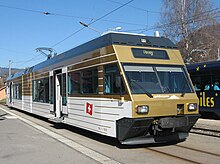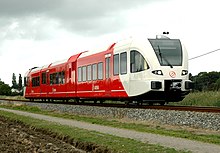
A diesel multiple unit or DMU is a multiple-unit train powered by on-board diesel engines. A DMU requires no separate locomotive, as the engines are incorporated into one or more of the carriages. Diesel-powered single-unit railcars are also generally classed as DMUs. Diesel-powered units may be further classified by their transmission type: diesel–mechanical DMMU, diesel–hydraulic DHMU, or diesel–electric DEMU.

A railcar is a self-propelled railway vehicle designed to transport passengers. The term "railcar" is usually used in reference to a train consisting of a single coach, with a driver's cab at one or both ends. Some railway companies, such as the Great Western, termed such vehicles "railmotors".

The Siemens Desiro is a family of diesel or electric multiple unit passenger trains developed by Siemens Mobility, a division of the German Siemens AG conglomerate. The main variants are the Desiro Classic, Desiro ML, Desiro UK and the later Desiro City, Desiro HC and Desiro RUS. The trains are mostly used for commuter and regional services, and their rapid acceleration makes them suitable for services with short distances between stations. The design is flexible, and has become common in many European countries.

Stadler Rail AG is a Swiss manufacturer of railway rolling stock, with an original emphasis on regional train multiple units and trams, but moving also into underground, high speed, intercity and sleeper trains. It also produces niche products, such as being one of the last European manufacturers of rack railway rolling stock. Stadler Rail is headquartered at its place of origin in Bussnang, Switzerland. Stadler Rail employed 13,900 employees by 2023.
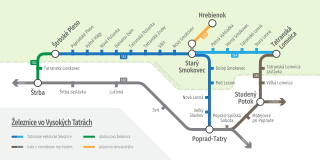
The Štrbské Pleso–Štrba rack railway is a 1,000 mm gauge narrow-gauge railway in the High Tatras. It was built in 1896 and reconstructed in 1970. At the valley terminus, it connects to the standard-gauge main line between Bratislava and Košice, and at the mountain terminus, it connects to the Tatra Electric Railway.
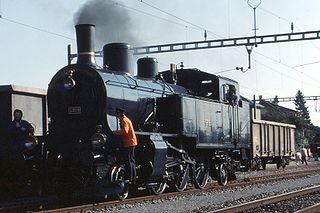
For more than a century, the Swiss locomotive, multiple unit, motor coach and railcar classification system, in either its original or updated forms, has been used to name and classify the rolling stock operated on the railways of Switzerland. It started out as a uniform system for the classification and naming of all rolling stock, powered and unpowered, but had been replaced and amended by the UIC classification of goods wagons.

Stadler FLIRT is a passenger multiple unit trainset made by Stadler Rail of Switzerland. The baseline design of FLIRT is an electric multiple unit articulated trainset that can come in units of two to twelve cars with two to six motorized axles. The maximum speed is 200 km/h (125 mph). Standard floor height is 57 cm, but 78 cm high floors are also available for platform heights of 76 cm.

The NS Class 3400 was a series of diesel multiple unit which were in service in the Netherlands between 1996 and 2017 and were built by Duewag, Talbot and SIG between 1996 and 1998. They were operated by the Nederlandse Spoorwegen and between 1999 until 2014 under lease by Syntus. The class is referred to as DM'90 meaning diesel rolling stock of the 1990s or Buffel, which means Buffalo. The DM'90 series was developed alongside the short lived, electric SM'90 series with which it shares the unusual body cross section. Class 3400 were the last DMUs in service with NS, the older DE3 and DH1/2 ("Wadloper") series having been replaced by the diesel electric Stadler GTW which are still in use with other operators in the Netherlands. Since January 2018, all units are now stored out of service and 32 units have been sold to SKPL - Polish private railway operator, where they are reclassified as SD85.
The Stadler Regio-Shuttle RS1 is the first widely used, new-generation, diesel railcar in Germany and Czech Republic for local railway services. Its most characteristic feature is the trapezium-shaped window frames. The Regio-Shuttle is classified by the Deutsche Bahn as Class 650, by the České Dráhy as Class 840 or Class 841, however numerous private railways have their own Regio-Shuttles.

The Brig-Visp-Zermatt-Bahn ABDeh 8/8, now known as the Matterhorn Gotthard Bahn ABDeh 8/8, is a three member class of metre gauge, rack rail, electric multiple units operated until 2002 by the Brig-Visp-Zermatt-Bahn (BVZ), and since then by its successor, the Matterhorn Gotthard Bahn (MGB), in the Canton of Valais, Switzerland.

The ZSSK Class 425.95, is a class of metre gauge electric articulated trains currently operating on the Tatra Electric Railway (TEŽ), in the Prešov Region of northeastern Slovakia. They are part of the Stadler GTW family of rail vehicles, developed by Stadler Rail.

The Brig-Visp-Zermatt-Bahn Deh 4/4, now known as the Matterhorn Gotthard Bahn Deh 4/4 21–24, is a four member class of metre gauge, rack rail, electric multiple unit power cars operated until 2002 by the Brig-Visp-Zermatt-Bahn (BVZ), and since then by its successor, the Matterhorn Gotthard Bahn (MGB), in the Canton of Valais, Switzerland.

The Matterhorn Gotthard Bahn ABDeh 4/8, also known as Komet, is a two member class of metre gauge electric trains operated by the Matterhorn Gotthard Bahn (MGB), in the Canton of Valais, Switzerland.

The Matterhorn Gotthard Bahn ABDeh 4/10, also known as Komet, is a three member class of metre gauge electric trains operated by the Matterhorn Gotthard Bahn (MGB), in the Canton of Valais, Switzerland.

The RABe 520 is an electric multiple unit used since 2002 by the Swiss Federal Railways. It is based on the Stadler GTW 2/8 model.
P.A.Th.E./P, which stands for Patras–Athens–Thessaloniki–Idomeni/Promachonas is a higher-speed rail line in Greece which is partly completed and partly under construction. The section between Athens and Thessaloniki is completed and allows a travel time of 3 hours 20 minutes, a reduction of about three hours.

The Stadler Citylink is a series of tram-trains manufactured by Stadler Rail at its Valencia factory since 2011. The design was introduced by Vossloh España before their takeover by Stadler Rail in 2015. They are currently used in Germany, Hungary, Mexico, Spain and the United Kingdom, with more on order in Austria. Stadler opened a new factory in the United States in 2016, which is in the process of building up to 80 Citylink vehicles for service in Salt Lake City beginning in 2028.
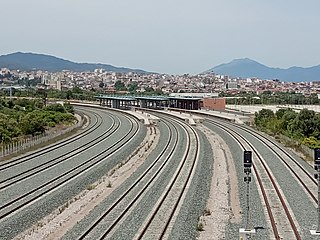
Aigio railway station is a train station in Aigio in the northern Peloponnese, Greece. Since June 2020, it is served by Hellenic Train local services to Kiato. The station is located on the outskirts of Aigio, 2 km from the town's centre.
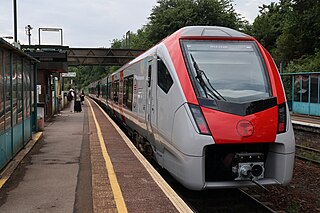
The British Rail Class 231 is a class of eleven diesel-electric multiple units of the FLIRT family, which have been built for Transport for Wales by Swiss rolling stock manufacturer Stadler Rail. The first units entered service on 18 January 2023.

In Greece, there are two similar classes of Stadler GTW trainsets, namely the 560 and the 4500, which are operated by TRAINOSE and are part of OSE rolling stock. These are suburban DMUs with two coaches, of type G.T.W. 2/6, which were built by a consortium of Stadler, Bombardier and Hellenic Shipyards and were put into operation by OSE, between 2003 and 2004. The trainsets are either standard or metre gauge, but with the same technical characteristics. They can be coupled in multiple coupling with up to three railcars.



